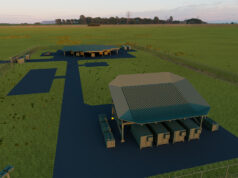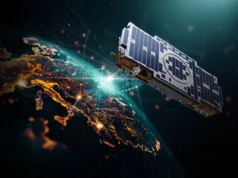The UK Space Agency has unveiled the first beneficiaries of its £20 million International Bililateral Fund.
The initiative is aimed at fostering collaborations between UK organisations and their counterparts from the US, Canada, Australia, Japan, India, Singapore, South Africa, and other countries to advance space research and technology.
According to a press release, the International Bilateral Fund represents the UK Space Agency’s maiden venture into enhancing international partnerships to fulfil the UK’s ambitions in space. While some initiatives will centre on bolstering ties to create future economic prospects for the UK, others will zero in on scientific missions and technologies with lucrative commercial possibilities.
The projects in this venture span a range of areas, from employing superconductors in spacecraft control to satellite launch mechanisms and space traffic management.
“Working with other space agencies and organisations across the globe through our International Bilateral Fund allows us to draw on skills that enhance our homegrown expertise and capabilities, drive up investment in the UK, and support world-class science and discovery,” commented Dr Paul Bate, Chief Executive of the UK Space Agency. He emphasised the significance of such collaborations in propelling space innovation, unlocking commercial benefits, and furthering global advancements in the sector.
Among the projects, UK-based Vertical Future will collaborate with Axiom Space, Saber Astronautics, Cambridge University, and the University of Adelaide. Their focus will be on designing a cutting-edge autonomous environment for plant growth, which is crucial for space expeditions.
In addition, satellite manufacturer In-Space Missions will partner with regional Asia-Pacific Government collaboration to initiate Faraday Dragon. This programme is dedicated to simplifying the export process of innovative space technologies and offering easier access to space via rideshare missions.
Lizzie Kerr, Director of UKspace stated:
“UKspace welcomes the announcement of the first projects funded under the UK Space Agency’s International Bilateral Fund. International collaboration underpins the success of the UK’s space sector – and this new programme is an important new route to unlock new international partnerships, benefitting companies overseas and here in the UK.”
The announced collaborations, each obtaining up to £75,000 from an initial £2.1 million pot, span various fields and involve international partners from all over the globe. Some noteworthy collaborations include:
- University of Glasgow with the Australian Remote Operations for Space and Earth Consortium on a novel lunar regolith sampling technique.
- Rolls-Royce partnering with BWXT Advanced Technologies LLC (USA) on space nuclear technology development.
- Satellite Applications Catapult and Obruta Space Solutions Corp (Canada) working on a low-Earth orbit regulatory and technology testbed.
- Seraphim Space Camp Accelerator Ltd joining forces with multiple Singapore-based entities on their expansion into Asia.
- In-Space Missions collaborating with several Asia-Pacific entities on the Faraday Dragon project, a technology and business accelerator programme.
And numerous other collaborations with entities from the USA, Australia, Japan, Canada, Germany, Singapore, UAE, Bahrain, and more, focussing on various aspects of space research, development, and technology.












£20 million? 😴
Yes, £20 million: checked the figure on YouGov.
Sorry, Gov.uk: too early in the morning.
Hmmm… intriguing. 🤔 Anyone else notice that there are not only cooperative ventures being formed w/ current AUKUS members (i.e., Oz, US), but also probable future AUKUS Pillar 2 associates (e.g., Canada, Germany, Japan, Singapore, etc.)? And, more specifically, that RR is teaming w/ a US contractor re ‘space nuclear technology development?’ Guilty perhaps of attempting to read tea leaves, but believe some parties in HMG are indulging in some joined up thinking, and can discern the probable path of future dual use (civilian/military) R&D in space related programs. Believe this investment, if persistent, will pay handsome dividends in both arenas in the out years. 🤔😳🤞
Yes RR modular reactor technology is very much being produced with Space in mind. There are various future Space technology that will be reliant upon the power from such reactors and for the first time Space X offers (eventually) the opportunity to exploit them. Eventually fusion will be the more appropriate power source but that is further more in the future. However read about a novel potential fusion reaction drive (I think of Canadian origin) that actually can be created via a Nuclear fission Reactor, a prototype of which is planned to be tested later this decade. All still speculative but such reactors will play an important role if Space X and others plans start to work out.
Thanks for providing some additional details. Believe there will be greater advancement in space during the next twenty-five yrs. than the previous fifty, at least partially spurred by competition w/ the despots. AUKUS Pillar 2 will prove to be a very convenient organizational umbrella for a majority of the military applications. Hopefully, enough technocrats remain in government to ensure the ‘final frontier’ high ground is not ceded to either the slobbering Orcs (unlikely), or the scum-bag, slimeball ChiComs (distressing possibility). 🤞🤞
£20 million for the development of an autonomous plant growing environment. That’s a lot for a flying hydroponics design. Heck that’s easily done now with current technology.
There is a whole farm in an old disused underground tunnel in London using hydroponics.
I know that’s not all the £20 million was going towards but my point is a viable design is easily possible.
I assume you’re talking about this project…
Vertical Future Ltd and University of Cambridge x University of Adelaide (Australia), Axiom Space (USA), Saber Astronautics (Australia and USA) – Autonomous agriculture to support space exploration.
I’m no expert but I assume that the “to support space exploration” bit means that it’s intended to deliver an autonomous system (and I can’t imagine it being anything other than hydroponics) that works in space, maybe in very low gravity e.g. Lunar surface, or in micro gravity e.g. in a space station in low-Earth or some other orbit. I can imagine that micro gravity in particular might create some unique challenges in terms of nutrient flows and plant health that might not be encountered in that London hydroponics farm.
Also, such a system needs to get into space in the first place. As crazy as some delivery drivers might be, I don’t think that when that London farm was being built any of the delivery drivers will have been subjecting their loads to 3g forces (possibly more for a cargo launch – 3g tends to be the limit launch providers target for crewed launches). There can also be very intense vibrations during launch that any system needs to be able to survive. Plus any control systems probably need to be radiation hardened and some of that custom electronics can get very expensive.
And another thing is the cost of getting mass to orbit. Every kg matters so this project will presumably be looking at any way it can optimise mass which in some cases might mean totally re-engineering mechanisms used in that London plant because they didn’t/don’t need to care about mass so are excessively heavy when considered in the context of space exploration. Power efficiency is probably also a key consideration. And their targets for how much of a closed loop the system is (what percentage of the inputs can be recycled) would also I expect be far more critical for this project vs an Earth-based hydroponics farm. I’m sure Earth-based farms do care about efficiency & input recycling but probably not to the “squeeze out every possible extra 0.5%” degree that a space-based system is likely to care about.
I’m not claiming I’m an expert in this but sometimes it is all too easy for even an intelligent person looking at someone else’s area of expertise from the outside to be unaware of the particular complexities that are not immediately apparent to an outsider. It reminds me of a conversation I had when I was dealing with various Formula 1 car manufacturers. Stopping an engine seizing up by designing a decent oil system is a pretty well-understood area right? Manufacturers of engines for ships, cars, generators etc have been doing it for decades. Well, regular oil distribution systems won’t work on an F1 car because the g forces the engine is subjected to when it is undergoing major acceleration (and going round a bend at fixed speed is also acceleration since velocity is a vector) causes all sorts of havoc if for instance a regular sump is used and the design of an oil system that actually keeps oil flowing under those harsh g forces is quite challenging.
Anyway, there’s a lot of exciting projects in there so it’s good to see them getting some support from the UK Space Agency.
Yes well explained, virtually nothing we take for granted here operates the same in low or no gravity or when there is no or a different atmosphere. Would have assumed that was obvious to a degree actually but in reality it’s far greater and complex than we imagine.
Yeah loads of electric motors operating here too, but hey you can’t just run them in Space, you need substantial extra work to make them work remotely as expected. We tend to take gravity and atmosphere for granted down here.
Our India focused Prime Minister oversaw the Aid buget to india increase by 70% to £57 Million. Compare that figure to the £20 million above.
Why are we still giving any aid whatsoever to India?
They have a population of 1.2 billion, a successful space programme, indigenous aircraft carrier capability and generally are getting on just fine. Don’t need any UK aid at all.
For £57 million we could upgrade another 40-50 C2s to C3 standard and probably fit the whole fleet with Trophy APS.
57M would pay for about 10 upgraded CH2 to CH3 tanks max.